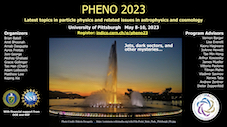Conveners
DM I
- Javier Acevedo (SLAC)
We present a new calculation of dark matter-electron scattering rates in semiconductors using atomic centered gaussian basis sets within the framework of density functional theory. We treat both core and valence orbitals similarly and compare with prior results, emphasizing the importance of all-electron effects, which enhance dark-matter electron scattering rates at high recoil energies. We...
Direct detection for sub-GeV dark matter is developing rapidly, with many novel experimental ideas and theoretical methods emerging. In this work, we extend the dielectric formalism for dark matter scattering to incorporate anisotropic material responses, enabling directionally-sensitive experiments with a broad class of target materials. Using a simple model of an anisotropic electron gas, we...
The Migdal effect, ionization induced by a nuclear recoil, is an important atomic process for pushing conventional dark matter searches into the MeV mass range. The Migdal effect has of yet not been definitively observed using standard model probes. We have studied the viability of measuring the neutron induced Migdal effect in liquid xenon, silicon, and liquid argon. We present the results of...
SENSEI (Sub-Electron Noise Skipper Experimental Instrument) is a direct detection dark matter experiment with detectors operating at Fermilab and at the SNOLAB underground facility. The experiment consists of silicon Skipper-CCD sensors that make multiple non-destructive measurements of the charge contained in each of millions of pixels, reducing the readout noise to a level that allows for...
Pulsar timing arrays (PTAs) are a powerful tool to study dark matter (DM) substructure. Transiting lumps of DM can induce shift in pulsar timings due to Doppler and Shapiro effects. In this talk we first briefly review the principle of DM detection with PTAs. We then show the projected reach using the projected subhalo mass function and density profile of DM substructure from various models....
Several BSM predicted particles could give rise to resonant particle pair production. We will present the results of a search for prompt low-mass dimuon resonances based on proton-proton collision data at a center-of-mass energy of 13 TeV collected by CMS. The search exploits a high-rate trigger ("scouting") stream to record events with two muons and looks for narrow peaks in the dimuon mass...
Dark matter may exist as an ultralight bosonic particle, leading to the formation of an ever-present field that could interact with us via a new long-range fifth force. Recently, quantum sensing techniques have been shown to be promising avenues with which to detect such a dark matter candidate. However, these studies did not entirely capture the stochastic nature of the field, which is...
Although searches for GeV-scale WIMPs are sensitive to very small cross sections, constraints on sub-GeV dark matter are significantly weaker, and largely constrain moderately- or strongly-interacting dark matter. But if dark matter interacts too strongly with nuclei, it could be slowed to undetectable speeds in Earth’s crust or atmosphere before reaching a detector. For sub-GeV dark matter,...

